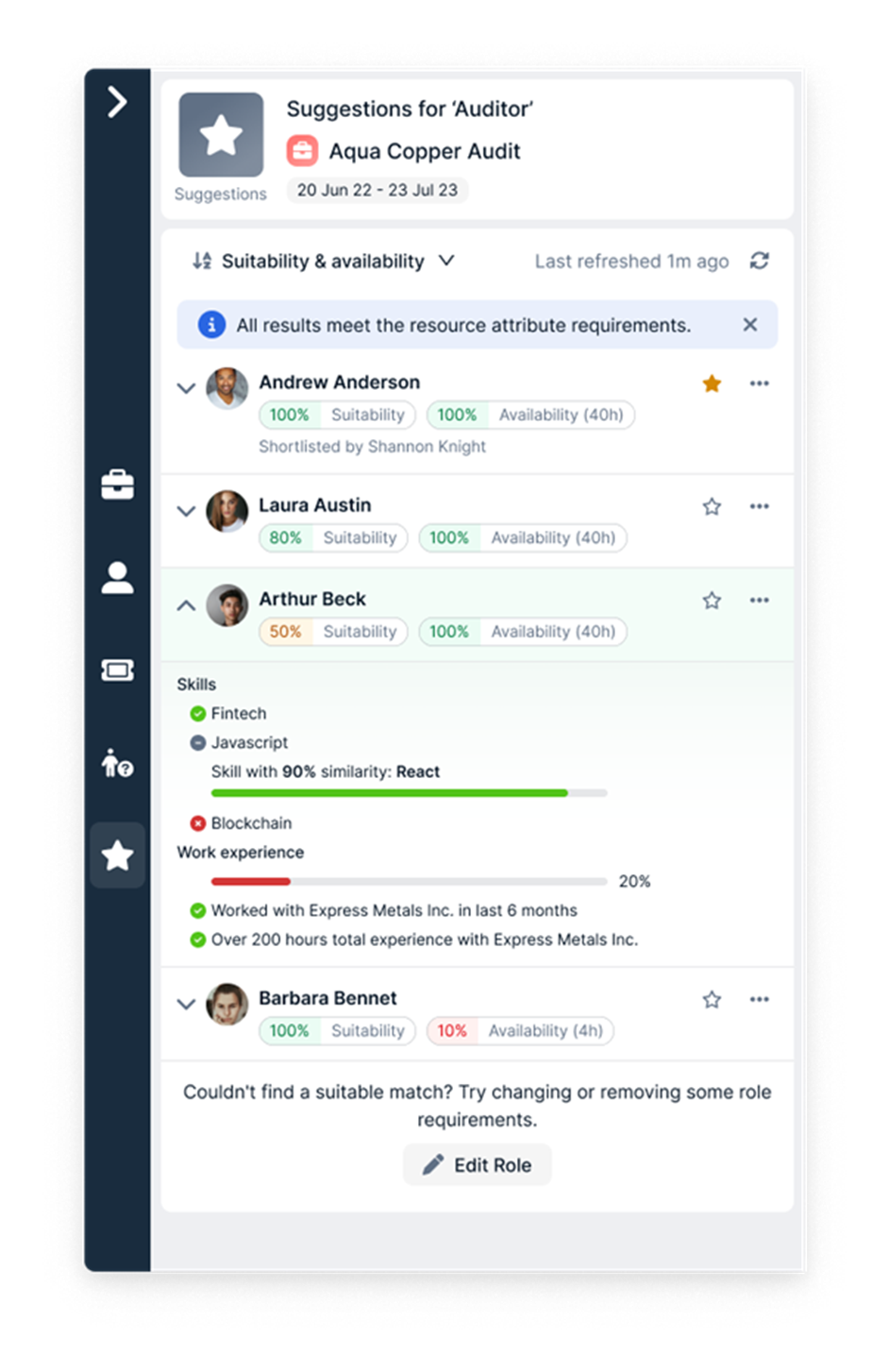Ensuring your staff, resources, and client budgets are all precision planned to optimise resources can boost the bottom line But resource forecasting, planning and management can be hard without the right approach. So, how can you generate reliable resource projections?
Thankfully, there are tried and tested methods that experts use for optimal resource forecasting. And we’re here to help. In this blog, we’ll look at resource forecasting techniques that can boost your planning confidence and set the stage for future growth.
➡️In this blog, we’ll cover:
- Why resource forecasting matters
- How to look at historical data
- Why you need to follow the market
- The benefits of running customer surveys
- The importance of cataloging skills
- Why run scenario planning
- How the right tech helps
Let’s get into it.?
Why resource forecasting matters
Pin-point accuracy in forecasting resource requirements can literally make or break business growth. As a professional services-based business, your people are likely your biggest asset and also your greatest expense. And so to hit profit margin goals, and keep clients satisfied, you need effective resource forecasting.
Effective resource forecasting includes:
➡️Having the right talent for each project – without over or under-utilising their skills.
➡️Spotting potential bottlenecks – like relying on one person for a certain task.
➡️Sticking to budget – tracking salaries, raw materials, equipment and more.
➡️Limiting risk – preparing for shortfalls like employee absences.
➡️Generating ROI – by tracking KPIs.
This is why resource forecasting is key. It literally allows you to avoid bottlenecks, deliver on client promises, and seize opportunities of heightened demand.
Ready to see how you can create more accurate resource forecasts? Read on for six tried-and-tested resource forecasting techniques. ?
Resource forecasting technique #1: Look at historical data
Your own historical data is a goldmine for insight. It acts as a valuable guide for future forecasting because it allows you to see how long projects have taken in the past, like if time is over or underused. Nuggets of insight such as this provide greater provision for shaping future resource estimates.
Moreover, you can track seasonal changes throughout the year. By this, we mean peaks and troughs in resource requirements. For example, there will likely be heightened demand, client side, or annual leave breaks, business side – which you can factor into resource planning.
Here’s a simple guide to incorporating this insight into resource forecasting:
1. Gather your data together from previous years – in one place.
2. Look for noticeable trends – like customer demand changes.
3. Segment data further for granular insight into service types, departments, or regions – this enables precision resource allocation.
4. Tweak your forecast models – to allow for scaling up and down or planning leave during peaks and troughs in demand.
Recording data in real-time is a game changer here, as it allows you to see where resources are being allocated, instantly – which allows you to pivot your resource allocation strategies.
Resource forecasting technique #2: Follow the market
As well as trends spotted within your business, it's best practice to keep an eye on patterns and trends in the industry, as these will undoubtedly have an impact on your operations. Why? Because resource needs follow economic ups and downs and that’s why leading businesses keep an eye on indicators like unemployment, confidence indexes, and GDP for the industries they work with.
And let’s not forget one golden source of industry insight: Clients. ✨

Your teams will have an ear to the ground and hear first-hand what’s shaking up your client’s businesses. Spotting trends early allows you to predict how the market seems to be going and the likely future needs.
The bottom line? This insight helps to prevent poor resource allocation, wasted resources, and missed opportunities. And it allows for efficient resource forecasting and planning.
Resource forecasting technique #3: Run customer surveys
If your teams aren’t picking up nods to future needs whilst working with clients, it may be worth conducting a customer survey. This can help you to understand upcoming needs and allow you to strategically plan ahead to meet demand.
For example, you can create a short survey which captures their upcoming challenges, new strategies and likely orders.
Of course, even the shortest surveys take up their time, so you will need to offer a survey to boost response rates. And for your business to benefit, make sure responses are easy to collect and analyse so that you can stay agile and quickly act on insights.
Regularly running these surveys helps you to keep your finger on the pulse and show that you have an interest in the client's needs.
Resource forecasting technique #4: Fully catalogue employee skills
This is a must for efficient resource allocation as it allows you to accurately match employees to projects. Essentially, this allows you to maximise the use of their strengths for increased productivity, and ultimately creates a higher return on their salaries – boosting profit margins.
With resource skills mapped, you can quickly find the right specialist (who is available) and adapt. This makes covering covering absences, or changes to client strategies much easier to manage.

(Retain’s resource management software allows you to dynamically schedule resources based on suitability and availability)
Plus, there are an abundance of additional benefits too, like:
✅ Optimises team members time by allowing you to easily see who is over or underused.
✅ Identifying any gaps in skills that may require new hires or additional training so that all bases are covered in addressing client needs – before they arise.
✅ Reduces skills loss when employees move on as you can ensure that the workforce has multiple people covering a set of skills, rather than just one expert that you rely solely on.
Mapping out the skills sets for all employees will be crucial for the next resource forecasting technique.
Resource forecasting technique #5: Run scenario planning
Whilst you cannot predict the future, you can prepare for uncertainties by creating ‘what-if’ scenarios which allow you to act out your worst-case scenarios and prepare back-up plans.
If you’ve not done this resource planning technique before, here are a few pointers:
➡️Step 1: Identify the key variables that affect resource allocation – this might be employee holidays or downtime for clients.
➡️Step 2: Use these variables to build multiple scenarios. For instance, what happens when there’s high employee absence and high demand? How can you prepare for this?
➡️Step 3: Use the output of this to create plans that allow you to adapt when you hit adversity. The more scenarios you think of, the better the resource planning strategy becomes.
Looking for an easier way to do this? Using a dedicated software tool allows you to make quick alterations. Here’s more ?
Resource forecasting technique #6: Lean on resource forecasting software
Why sift through spreadsheets when you can have real-time data at your fingertips? This is where resource forecasting software comes in.
Advanced systems, like Retain, can automate a lot of these techniques – making it easier to collect and analyse data (rather than manually trawling through disparate spreadsheets). If you’ve ever tried to build “what-if” scenarios manually, you’ll know they can be highly time-consuming. With the right tech, this can be done in minutes.
What’s more, cloud-based resource planning tools can be viewed by everyone so all teams are kept on the same page with planning – you can even filter access so sensitive information is only available to certain team members.
Better yet, this data and the decisions you make can be made in real-time. Saving time on resource scheduling and, more importantly, allowing you to respond quickly to new client requests and emergencies.
?Read more: AI-powered tools and software for resource management
Boost the bottom line with the right resource forecasting techniques
With these proven resource forecasting techniques, you can significantly improve resource forecasting reliability. And with this, you can work towards leaner operations, better profit margins, as well as reducing risky shortfalls.
Ultimately, combining all of these resource forecasting techniques – like leveraging historical data and scenario planning – allows you to create robust and flexible forecasting models. Sounds like a lot to handle? This is where technique six provides profit-boosting power because it allows businesses to deploy these strategies much quicker and more easily.
Key takeaway: The move to AI-powered software solutions to manage resource planning is how leading businesses are future proofing resource forecasting.
?In fact, Gartner predicts that by 2024, businesses will lower operational costs by 30% through leveraging automation tech.
Your next steps: Looking to revolutionise your resource planning today? Get a personalised demo of Retain’s resource management software.
Or if you're looking for more resource forecasting insights check out these posts:
?How resource forecasting helps with risk management


